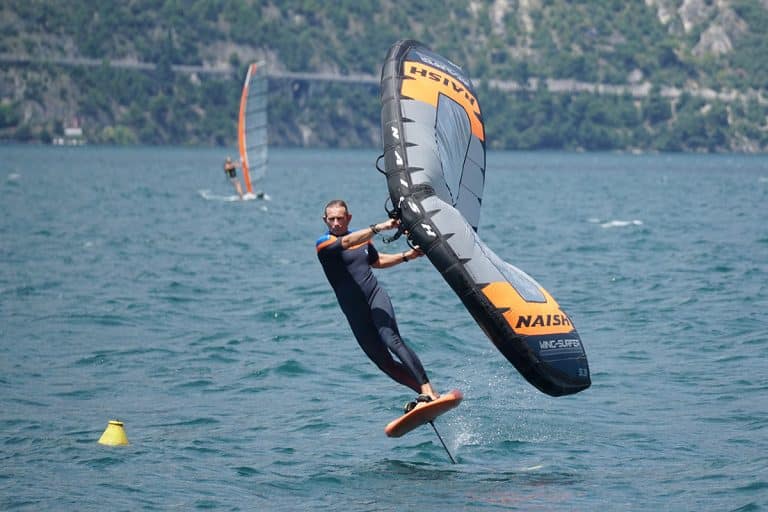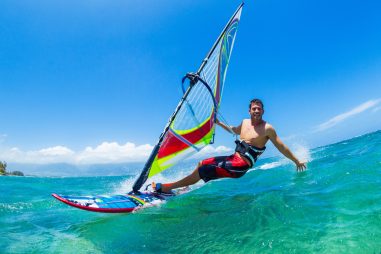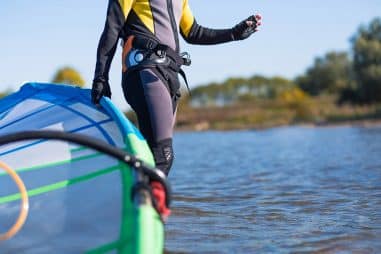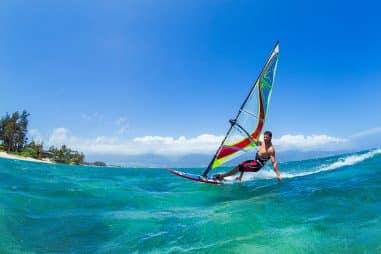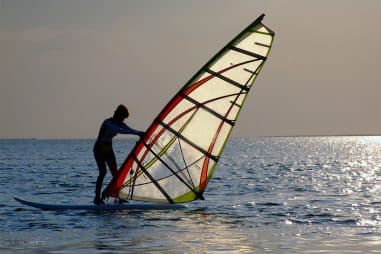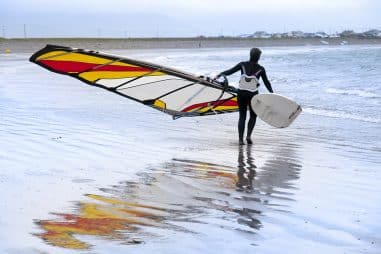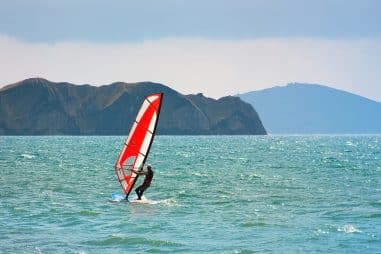Let’s face it, one downside of windsurfing is not being to do it more, especially if the speed of the wind is not strong enough. Well, fret not! Foil windsurfing has everyone celebrating! This revolutionary take on the watersport makes it possible for everyone to be able to windsurf even in lighter wind conditions.
How Does a Windsurfing Foil Work?
Foil windsurfing basically follows the same fundamentals that windsurfing is built on, except that you would be flying above the water. Aside from that, you would need to ditch your old windsurfing gear for a more specially designed windsurfing board and windsurfing hydrofoil that would enable you to fly in locations with as little as 6 knots of wind.
Hydrofoils, also commonly called as foils, are wings that are designed to lift your windsurfing board above the water. There will be zero friction between the water and your board precisely because you will be windsurfing several inches above the sea.
Foils also lessen the hydrodynamic drag your board experiences when windsurfing. Overall, foil windsurfing gives you the sensation of flying rather than riding the wave, which is the case in regular windsurfing.
How Do You Windsurf With Foil?
While it is ideal that you have already mastered windsurfing skills like jibing, waterstart, planing, upwind and downwind sailing, and uphauling before you get into foil windsurfing, you can still learn the sport even if you are a windsurfing virgin. However, it would take a little more time. There are also several things to consider if you are a first timer in foil windsurfing.
For starters, ditch long masts for shorter, more manageable ones around 15 inches in length, as this will help you learn safer and faster. You would also need to consider the placement of your foot straps, where to put your weight, the pressure you will put on your front and back feet, and the slightest movement that your body will make.
Regular windsurf needs wind gust to start pumping, but you don’t need to wait for strong winds to get you started in foil windsurfing. Here are some tips to get you pumping and flying on your foil windsurf.
- While wind gust can help you fly faster, you can independently start your windsurf without it. Since you can ride even in a location with light wind conditions, you get to decided when to kickstart flying.
- In a regular windsurf board, you need to place your feet in the middle of the board. However, when you are foil windsurfing, the placement of your feet should be towards the upwind rail and not in the center.
- Once you are ready and you are in a comfortable position on the board, pump 2 to three times. This will power up your sail and get your board moving.
- Remember to put your front foot in the foot strap immediately and once you are correctly strapped in, make two big pumps. The first pump will power the sail, and the second pump will lift your foil.
- With your back foot, push vertically instead of sideways. This movement will help sink the tail of the board, thus, generating lift.
- You must only hook on your harness once you find your balance, you are in a comfortable position, and you have complete control of the foil.
- Remember to strap in your back foot as your windsurf picks up speed.
- If your board still touches the water after you have picked up speed, use your back foot to firmly push the tail of the board to lift the nose. If you are successful, the board will now be lifted out of the water.
How Hard Is Foil Windsurfing?
The answer lies in whether you already know how to windsurf or not. For windsurfing beginners (as in those who have never been aboard a windsurfer), it can be very challenging. But if you already have prior windsurfing knowledge, then it would be relatively easy for you to take it up a notch and learn foil windsurfing.
Like any sport, whether performed in land, water, or air, foil windsurfing does have a learning curve, and it is possible that you will struggle in controlling the foil in the beginning. But If you continue with the sport and are guided by qualified instructors, you will soon learn how to move your body and position your board correctly.
The great thing about foil windsurfing is that the science behind it makes it very suitable for everybody to learn regardless of gender, fitness level, skill level, or age.
Is Foil Windsurfing Dangerous?
As with any sport, foil windsurfing has its risks. While it is a relatively low-risk sport, being extra careful and making sure that you are safe makes all the difference. You must remember that foil windsurfing is as safe or as dangerous as you make it to be, so you must never pursue it recklessly.
There are many things that you can do to ensure your safety while foil windsurfing. For starters, you should never, ever skip on wearing protective gear as it is your first layer of defense against possible injuries.
Make sure that you always wear your impact vest and helmet whenever you go foil surfing to protect you from head and chest injuries. This is very important because catapult crashes are very frequent, especially for beginners. It is also recommended to wear your wetsuit and boots to protect you in case you kick the foil while you are submerged underwater.
How Do You Carry a Windsurf Foil?
There are different ways on how to carry your windsurf foil. They vary according to your chosen windsurfing location, the speed of the wind, and whether you can assemble it in or out of the water.
One of the easiest ways to carry your windsurf foil is by bringing them to the water. Start with the sail, followed by the board, and then slowly assemble the equipment in the water. However, this way may not always be possible, especially if your location has big tides or currents or the seabed is littered with sharp stones.
If you are faced with these conditions, then you can opt to carry the assembled equipment to the water. You can do this by carrying the windsurfing equipment atop your head while facing the wind.
Because there is no strict rule on how to carry your windsurf foil, you can always choose to do what works best for you. Just be mindful of the foil windsurfing environment that you are in and how you can safely carry your equipment.
Happy foil windsurfing!

